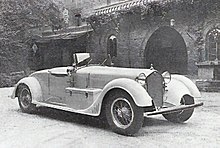Carrozzeria Garavini
| Carrozzeria Garavini Stabilimenti Garavini
|
|
|---|---|
| legal form | Corporation |
| founding | 1914 |
| resolution | 1957 |
| Reason for dissolution | Takeover by Viberti |
| Seat | Turin , Italy |
| management | Eusebio Garavini |
| Number of employees | 230 (1929) |
| Branch | Body shop |
The Carrozzeria Garavini was an Italian manufacturer of automobile bodies , which especially in the interwar period, special bodies for chassis of Alfa Romeo , Fiat and Lancia produced. In addition to bodies for passenger cars, Garavini also produced commercial vehicles and ambulances.
Company history
prehistory
The founder of the company was Eusebio Garavini (born July 23, 1878, † May 6, 1947) from Forlì . Since 1899 Garavini had worked for the Turin company Diatto , which at the time was primarily manufacturing luxury railroad cars. In 1905 Eusebio Garavini became director of the newly founded Carrozzeria Taurus in Turin, which mainly manufactured bus bodies. Two years later, with financial support from the Diatto owners, he founded Carrozzeria Piemonte , which primarily works as a supplier for Diatto and was at times its official bodywork supplier. After economic difficulties, the Carrozzeria Piemonte was liquidated in 1911. Their equipment was taken over by the newly founded company Diatto, Garavini & C. , in which, in addition to Eusebio Garavini, the Diatto family was also involved and which in the following years was again Diatto's preferred body supplier. In 1911 the company had at least 50 employees. In 1914 the Diatto family withdrew from the business. The company then renamed Carrozzeria Garavini.
The company from 1914 to 1957
After the Diatto family withdrew, the Carrozzeria Garavini produced only a few bodies for Diatto chassis. A business connection to the plant can no longer be proven after 1914. The bodies were now created on behalf of the customer. Garavini chassis from Alfa Romeo, Fiat, Isotta Fraschini , Itala and OM ; a few Bugatti chassis were also there. Garavini's superstructures were considered high quality; Customers included the royal families of Italy and Belgium and the Ethiopian Emperor Menelik II.
During the First World War , Garavini received several large orders for the construction of ambulances and troop transport vehicles. In the 1920s, Garavini rose to become one of the leading Italian bodywork companies. In 1926 Garavini produced around 1000 bodies. From 1927 onwards, Mario Revelli di Beaumont Garavini's superstructures were designed for a time , which until the early 1930s were mainly built on upper-class chassis. A trademark of Garavini was a partition between the driver and passenger compartment, which was often used in luxury sedans.
In the mid-1920s, the so-called Weymann bodies appeared in France , which consisted of a wooden frame covered with synthetic leather. In this way, material-damaging twisting and noise development should be reduced as much as possible. Numerous international car body manufacturers acquired licenses from patent holder Charles Weymann during this time . Carrozzeria Garavini, on the other hand, developed its own system without acquiring a Weymann license, which it called Plumelastica and patented in 1927.
In 1933 the company got into a crisis. The trigger was the suspicion of tax offenses, due to which Eusebio Garavini and his managing director Mario Fossari were temporarily arrested. After his dismissal in the following year, Eusebio Garavini took over the management of his company again, which he realigned. Instead of upper-class bodies, Garavini now produced standardized special bodies for the Fiat models 508 "Balilla" and 1500 , which were converted into convertibles or convertible sedans. Superstructures for passenger cars remained Garavini's core business; in addition, the plant also produced buses from 1925. In 1940 Garavini was the first Italian manufacturer to offer a three-axle bus. In addition, ambulance vehicles were still being built.
During the Second World War , Garavini produced only a few car bodies, including an extraordinary convertible on the chassis of an Alfa Romeo 6C 2500 manufactured in 1939 . Garavini primarily built military vehicles with electric drives on behalf of the state. After Eusebio Garavini's death in May 1947, his sons Aldo and Sergio took over the business. While Sergio retired early on to pursue a political career - from 1991 he was the first general secretary of the Partito della Rifondazione Comunista - Aldo tried to keep the business going by concentrating on the bus business. By 1952, some bus bodies were built , including those based on the Lancia Esatau . However, Garavini could not establish himself permanently. In 1957 the company was taken over by competitor Officine Viberti .
literature
- Nick Georgano: The Beaulieu Encyclopedia of the Automobile: Coachbuilding , Routledge, 2001, ISBN 9781136600722
- Alessandro Sannia: Enciclopedia dei carrozzieri italiani , Società Editrice Il Cammello, Torino, 2017, ISBN 978-8896796412
Web links
Individual evidence
- ↑ Biography of Eusebio Garavini on the website www.treccani.it (accessed on March 8, 2019).
- ^ A b c d Nick Georgano: The Beaulieu Encyclopedia of the Automobile: Coachbuilding , Routledge, 2001, ISBN 9781136600722
- ↑ Alessandro Sannia: Enciclopedia dei carrozzieri italiani , Società Editrice Il Cammello, Torino, 2017, ISBN 978-8896796412 , p. 536.
- ↑ Alessandro Sannia: Enciclopedia dei carrozzieri italiani , Società Editrice Il Cammello, Torino, 2017, ISBN 978-8896796412 , p. 420.
- ↑ Alessandro Sannia: Enciclopedia dei carrozzieri italiani , Società Editrice Il Cammello, Torino, 2017, ISBN 978-8896796412 , p. 198 f.
- ↑ Alessandro Sannia: Enciclopedia dei carrozzieri italiani , Società Editrice Il Cammello, Torino, 2017, ISBN 978-8896796412 , p. 254.
- ^ John Tipler: Alfa Romeo Berlinas , Veloce Publishing Ltd, 2016, ISBN 9781845849641 .
- ↑ Overview of the history of Carrozzeria Garavini on the website www.italianedacorsa.it (accessed on March 8, 2019).
- ↑ a b Alessandro Sannia: Enciclopedia dei carrozzieri italiani , Società Editrice Il Cammello, Torino, 2017, ISBN 978-8896796412 , p. 256.
- ↑ Illustration and description of the Alfa Romeo 6C2500 Garavini on the website www.royalautomobileclub.co.uk (accessed on March 8, 2019).


